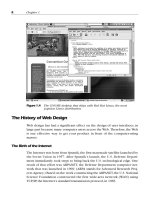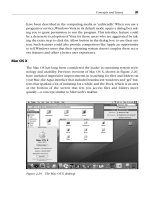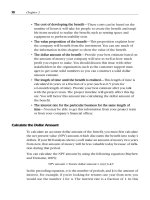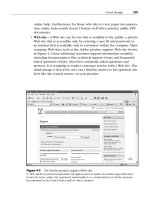jQuery UI 1 10 the user interface library for jquery
Bạn đang xem bản rút gọn của tài liệu. Xem và tải ngay bản đầy đủ của tài liệu tại đây (9.29 MB, 502 trang )
www.it-ebooks.info
jQuery UI 1.10:
The User Interface Library for jQuery
Build highly interactive web applications with
ready-to-use widgets
Alex Libby
Dan Wellman
BIRMINGHAM - MUMBAI
www.it-ebooks.info
jQuery UI 1.10:
The User Interface Library for jQuery
Copyright © 2013 Packt Publishing
All rights reserved. No part of this book may be reproduced, stored in a retrieval
system, or transmitted in any form or by any means, without the prior written
permission of the publisher, except in the case of brief quotations embedded in
critical articles or reviews.
Every effort has been made in the preparation of this book to ensure the accuracy
of the information presented. However, the information contained in this book is
sold without warranty, either express or implied. Neither the authors, nor Packt
Publishing, and its dealers and distributors will be held liable for any damages
caused or alleged to be caused directly or indirectly by this book.
Packt Publishing has endeavored to provide trademark information about all of the
companies and products mentioned in this book by the appropriate use of capitals.
However, Packt Publishing cannot guarantee the accuracy of this information.
First published: February 2009
Fourth published: December 2013
Production Reference: 1181213
Published by Packt Publishing Ltd.
Livery Place
35 Livery Street
Birmingham B3 2PB, UK.
ISBN 978-1-78216-220-9
www.packtpub.com
Cover Image by Aniket Sawant ()
www.it-ebooks.info
Credits
Authors
Project Coordinator
Alex Libby
Anugya Khurana
Dan Wellman
Proofreaders
Martin Diver
Reviewers
Aamir Afridi
Samantha Lyon
Islam AlZatary
Sandra Hopper
Stephen Holsinger
Indexers
Kristian Mandrup
Monica Ajmera Mehta
Marjorie Roswell
Priya Subramani
Acquisition Editors
Graphics
Joanne Fitzpatrick
Abhinash Sahu
Edward Gordon
Production Coordinator
Douglas Paterson
Aparna Bhagat
Lead Technical Editor
Akshay Nair
Cover Work
Aparna Bhagat
Technical Editors
Shashank Desai
Rosmy George
Jinesh Kampani
Manal Pednekar
www.it-ebooks.info
About the Authors
Alex Libby is from an IT support background. He has been involved in supporting
end users for the last 15 years in a variety of different environments, and currently
works as a Technical Analyst, supporting a medium-sized SharePoint estate for
an international parts distributor, based in the UK. Although Alex gets to play
with different technologies in his day job, his first true love has always been with
the Open Source movement, and in particular experimenting with CSS/CSS3 and
HTML5. To date, Alex has written five books based on jQuery, HTML5 Video, and
CSS for Packt Publishing, and has reviewed several more (including one on Learning
jQuery). jQuery UI 1.10: The User Interface Library for jQuery is Alex's sixth book with
Packt Publishing.
I would like to give a huge thanks to Dan Wellman for allowing me
the opportunity to update one of his books; it has been a pleasure
and a privilege. I just hope I've done justice to it! I also thank the
reviewers for their help in reviewing the book, along with their
constructive feedback. Thanks must also go to family and friends for
their support and encouragement; it makes working the long hours
all the more worthwhile.
Dan Wellman is an author and frontend engineer living on the South Coast of
the UK and working in London. By day he works for Skype and has a blast writing
application-grade JavaScript. By night he writes books and tutorials focused mainly
on frontend web development. He is also a staff writer for the Tuts+ arm of the
Envato network, and occasionally writes for .Net magazine. He's the proud father of
four amazing children, and the grateful husband of a wonderful wife.
www.it-ebooks.info
About the Reviewers
Aamir Afridi is a London-based frontend developer and has a passion for
JavaScript and jQuery. He has been working on different projects for Google,
YouTube, Facebook, and Apple. He is now helping TES in refactoring the frontend
architecture. He is always keen in learning new JavaScript frameworks and
wrote quite a few jQuery plugins and jQuery UI extensions. He can be found at
on the Web. He is aamirafridi on Twitter and GitHub.
Islam AlZatary graduated in Computer Information System from Jordan in 2008.
He worked for two years as a PHP web developer, and then he was appointed as a
frontend engineer at Bayt.com.
He deals with jQuery, jQuery UI, HTML/HTML5, CSS/CSS3, Bootstrap framework,
Mailer engine, JavaScript frameworks (RequireJS, AngularJS), and with all design
approaches (fixed, fluid, responsive, adaptive). He also likes the "mobile first
approach".
Stephen Holsinger has been developing on the Web professionally for over seven
years. He has worked for service companies and manufacturers, primarily focusing
on e-commerce platform and website development. His experience stretches from
backend system integration to frontend web development. He currently works as an
independent contractor lending his expertise to clients implementing retail sites on
the Demandware Commerce SaaS Platform.
www.it-ebooks.info
Kristian Mandrup has a master's degree in Computer Science from Copenhagen
University.
He has been developing software since he got his first computer at the age of 12
and has always been curious and always asks the hard questions: why? He likes to
push the techs to the limits and live on the bleeding edge. He is always on the move,
on new adventures and explorations, since the techs and tools never feel quite
good enough.
He is a toolmaker and an architect more than a traditional software developer. He
has crossed various platform boundaries over the year and has lately shifted from
the Ruby on Rails platform to the new frontier of Node.js and the MEAN stack. He is
currently exploring single-page, real-time applications. He likes to combine many
of the best techs available into a high-powered stack. This is where jQuery UI fits
in perfectly.
You can find Kristian on GitHub at and his
Twitter handle is @kmandrup.
Marjorie Roswell is a web developer from Baltimore, MD. She has been building
websites that serve the community for more than a decade.
She wrote the Drupal 5 Views Recipes book for Packt Publishing. She has developed
a GIS system for assisting citizen callers to the Baltimore Office of Recycling, and
has taught professional classes in desktop publishing, AutoCAD, and Drupal. She
currently serves clients as a NationBuilder website developer.
While in college, Marjorie received the Betty Flanders Thomson Prize for Excellence
in Botany. Her site is devoted to mapping and
charting federal food and farm policy.
The author of this book has a masterful knowledge of jQuery UI, and
Packt Publishing staff Anugya Khurana and Prachi Bisht have been
terrific to work with during the review process.
www.it-ebooks.info
www.PacktPub.com
Support files, eBooks, discount offers and more
You might want to visit www.PacktPub.com for support files and downloads related
to your book.
Did you know that Packt offers eBook versions of every book published, with PDF
and ePub files available? You can upgrade to the eBook version at www.PacktPub.
com and as a print book customer, you are entitled to a discount on the eBook copy.
Get in touch with us at for more details.
At www.PacktPub.com, you can also read a collection of free technical articles, sign
up for a range of free newsletters and receive exclusive discounts and offers on Packt
books and eBooks.
TM
Do you need instant solutions to your IT questions? PacktLib is Packt's online
digital book library. Here, you can access, read and search across Packt's entire
library of books.
Why Subscribe?
• Fully searchable across every book published by Packt
• Copy and paste, print and bookmark content
• On demand and accessible via web browser
Free Access for Packt account holders
If you have an account with Packt at www.PacktPub.com, you can use this to access
PacktLib today and view nine entirely free books. Simply use your login credentials
for immediate access.
www.it-ebooks.info
www.it-ebooks.info
Table of Contents
Preface1
Chapter 1: Introducing jQuery UI
7
Downloading the library
Using the hosted versions of jQuery UI
Setting up a development environment
Understanding the structure of the library
Examining the folder structure in detail
Working with ThemeRoller
Categorizing the component categories
Introducing the widget factory and effects
Browser support
Using the book examples
Library licensing
Introducing the API
Events and callbacks
Callback arguments
Summary
Chapter 2: The CSS Framework and Other Utilities
8
10
11
13
14
16
19
21
21
22
22
23
25
26
27
29
Working with the files that make up the framework
29
jquery.ui.all.css31
jquery.ui.base.css31
jquery.ui.core.css32
Explaining the individual component framework files
33
jquery.ui.theme.css33
Linking to the required framework files
34
Using the framework classes
35
Working with containers
35
Using interactions
37
www.it-ebooks.info
Table of Contents
Adding icons
39
Examining the icons in detail
Adding custom icons
Using custom icons – a note
40
41
43
Interaction cues
43
Switching themes quickly and easily
45
Overriding the theme
46
The position utility
49
Using the position utility
50
Explaining collision avoidance
52
Positioning with a function
54
Using the position widget in a real-world example
55
The widget factory
57
Summary58
Chapter 3: Using the Tabs Widget
59
Chapter 4: The Accordion Widget
85
Implementing a tab widget
60
Styling the Tabs widget
62
Applying a custom theme to the tabs
64
Configuring the Tabs widget
65
Working with tabs
66
Selecting a tab
66
Disabling a tab
67
Adding transition effects
68
Collapsing a tab
69
Working with the Tab events
69
Binding to events
71
Using tab methods
72
Enabling and disabling tabs
73
Adding and removing tabs
74
Simulating clicks
75
Destroying tabs
76
Getting and setting options
77
Working with AJAX tabs
79
Changing the URL of a remote tab's content
80
Displaying data obtained via JSONP
81
Summary83
Structuring the accordion widget
Styling the accordion
Configuring an accordion
[ ii ]
www.it-ebooks.info
86
89
90
Table of Contents
Changing the trigger event
91
Changing the default active header
92
Filling the height of its container
93
Using the accordion animation
95
Listing the accordion events
98
Using the change event
99
Configuring the beforeActivate event
100
Explaining the accordion methods
102
Header activation
102
Adding or removing panels
103
Resizing an accordion panel
106
Accordion interoperability
107
Using multiple accordions
109
Summary111
Chapter 5: The Dialog
113
Chapter 6: The Slider and Progressbar Widgets
141
Creating a basic dialog
Listing the dialog options
Showing the dialog
Setting a dialog title
Configuring the modality option
Adding buttons
Adding icons to the dialog buttons
Enabling dialog animations
Configuring the dialog's dimensions
Setting the z-index order of dialogs
Controlling the focus
Handling the dialog's event callbacks
Controlling a dialog programmatically
Toggling the dialog
Getting data from the dialog
Exploring dialog interoperability
Creating a dynamic image-based dialog
Summary
Introducing the slider widget
Custom styling
Configuring a basic slider
Creating a vertical slider
Setting the maximum and minimum values
Stepping with the slider widget
[ iii ]
www.it-ebooks.info
114
116
118
118
120
121
122
123
124
125
126
127
129
130
130
132
134
140
142
143
145
145
146
147
Table of Contents
Animating the slider widget
148
Setting the slider's value
148
Using multiple handles
148
Working with the range option
149
Using the slider's event API
151
Using slider methods
153
Practical uses
156
Creating a color slider
158
Introducing the progressbar widget
160
Listing the progressbar's options
162
Setting the progressbar's value
162
The progressbar's event API
163
Using progressbar methods
165
Adding indeterminate support
166
Responding to user interaction
168
Implementing rich uploads with a progressbar
173
Summary177
Chapter 7: The Datepicker Widget
Implementing the datepicker widget
Selecting dates using inline calendars
Configurable options of the datepicker
Using the basic options
Minimum and maximum dates
Changing the elements in the datepicker UI
Adding a trigger button
Configuring alternative animations
Displaying multiple months
Displaying the datepicker vertically
Changing the date format
Updating an additional input element
Changing the date format
Localizing the datepicker widget
Implementing custom localization
Implementing callbacks
Localizing a datepicker dynamically via rollup
Introducing the utility methods
Listing the datepicker methods
Selecting a date programmatically
Showing the datepicker in a dialog box
[ iv ]
www.it-ebooks.info
179
180
182
183
187
189
190
192
194
195
197
198
201
202
203
207
208
209
211
212
213
214
Table of Contents
Implementing an AJAX-enabled datepicker
Summary
Chapter 8: The Button and Autocomplete Widgets
Introducing the button widget
Implementing the standard buttons
Creating buttons using the <input> or <button> tags
215
218
219
220
220
222
Theming222
Exploring the configurable options
223
Adding the button icons
223
Input icons
225
Adding the Button events
226
Creating button sets
228
Checkbox button sets
Radio button sets
229
230
Working with button methods
Introducing the autocomplete widget
Working with local data sources
Using an array of objects as the data source
Configurable autocomplete options
Configuring minimum length
Appending the suggestion list to an alternative element
Working with autocomplete events
The autocomplete methods
Working with remote data sources
231
232
233
235
236
237
237
238
240
241
Passing a function as a source option
Displaying HTML in the list of suggestions
Summary
243
247
251
Retrieving content based on input
Chapter 9: Creating Menus
Implementing a basic menu widget
Exploring the menu CSS framework classes
Configuring menu options
Styling menus
Displaying the state of the selected menu options using icons
Adding dividers to menus
Using menu methods
Enabling and disabling menu options programmatically
Adding and removing menu items
Working with menu events
Binding to events
[v]
www.it-ebooks.info
241
253
254
257
259
260
260
262
264
265
266
268
271
Table of Contents
Creating horizontal menus
Combining with other widgets
Designing context menus
Enhancing a select menu
Summary
272
274
276
278
280
Chapter 10: Working with Tooltips
281
Chapter 11: Drag and Drop
315
Implementing a default tooltip
Exploring the tooltip CSS framework classes
Overriding the default styles
Using prebuilt themes
Creating custom themes with ThemeRoller
Configuring tooltip options
Positioning tooltips accurately
Using the position widget
Tracking mouse movement with tooltips
Displaying certain tooltips
Displaying AJAX content in tooltips
How can we tell if it has worked?
Using effects in tooltips
Working with HTML in tooltips
The dangers of working with HTML
Using tooltip methods
Enabling and disabling tooltips
Displaying tooltips programmatically
Handling tooltip events
Binding to tooltip events
Playing videos
Filling out and validating forms
Summary
282
284
284
285
288
289
290
292
293
295
296
298
298
299
302
302
303
304
306
308
309
311
314
The deal with draggables and droppables
316
Getting started with the draggable widget
316
Implementing a basic drag
317
Configuring the draggable options
318
Using the configuration options
320
Resetting the dragged elements
322
Adding the drag handle support
323
Adding the helper elements
324
Constraining the drag
327
Snapping328
[ vi ]
www.it-ebooks.info
Table of Contents
Draggable event callbacks
330
Draggable's methods
332
Getting started with the droppable widget
333
Configuring droppables
335
Configuring accepted draggables
335
Configuring drop tolerance
337
Understanding the droppable callback options
339
Setting the scope options for droppable
342
Configuring the greedy option
344
Droppable methods
347
Creating a maze game using the widgets
347
Summary351
Chapter 12: The Resizable Component
353
Chapter 13: Selecting and Sorting with jQuery UI
373
Implementing a basic resizable widget
Listing the resizable options
Configuring the resize handles
Adding additional handle images
Defining size limits
Resizing ghosts
Containing the resize
Handling aspect ratio
Resizable animations
Simultaneous resizing
Preventing unwanted resizes
Defining resizable events
Looking at the resizable methods
Creating resizable tabs
Summary
Introducing the selectable widget
Introducing the Selectee class names
Configuring the selectable component
Filtering selectables
Canceling the selection
Handling selectable events
Working with vast amounts of selectables
Working with selectable methods
Refreshing selectables
[ vii ]
www.it-ebooks.info
354
356
357
357
359
360
362
363
364
365
366
367
370
370
372
374
376
377
378
379
380
383
385
385
Table of Contents
Creating a selectable image viewer
386
Adding the behavior
388
Styling the image selector
391
Getting started with the sortable widget
392
Styling the sortable widget
396
Configuring sortable options
396
Placeholders402
Sortable helpers
403
Sortable items
405
Connecting lists
405
Reacting to sortable events
407
Connecting callbacks
411
Listing the sortable methods
413
Serializing414
Exploring widget compatibility
416
Adding draggables
417
Summary
422
Chapter 14: UI Effects
Using the core effects file
Using color animations
Using class transitions
Advanced easing
Highlighting specified elements
Adding additional effect arguments
Bouncing
Shaking an element
Transferring an element's outline
Scaling elements on a page
Exploding elements on a page
Creating a puff effect
Working with the pulsate effect
Adding the drop effect to elements
Implementing the sliding effect
Using easing
Understanding the blind effect
Clipping elements
Folding elements
Summary
[ viii ]
www.it-ebooks.info
425
426
426
429
431
431
433
434
436
436
439
441
443
445
447
449
453
454
456
457
459
Table of Contents
Appendix: Help and Support
461
Index
465
Downloading jQuery
Updating the code samples
Getting help
Changing themes
Getting help from the community
Need to ask a question?
Getting help via IRC chat
Asking at Stack Overflow
Reporting a bug in the library
461
462
462
462
463
463
463
463
464
[ ix ]
www.it-ebooks.info
www.it-ebooks.info
Preface
Modern web application user interface design requires rapid development and
proven results. jQuery UI, a trusted suite of official plugins for the jQuery JavaScript
library, gives you a solid platform on which you can build rich and engaging
interfaces with maximum compatibility, stability, and minimum time and effort.
jQuery UI has a series of ready-made, great-looking user interface widgets and
a comprehensive set of core interaction helpers designed to be implemented in a
consistent and developer-friendly way. With all this, the amount of code that
you need to write personally to take a project from conception to completion is
drastically reduced.
Specially revised for Version 1.10 of jQuery UI, this book has been written to
maximize your experience with the library by breaking down each component and
walking you through examples that progressively build upon your knowledge,
taking you from beginner to advanced usage in a series of easy-to-follow steps.
In this book, you'll learn how each component can be initialized in a basic default
implementation and then see how easy it is to customize its appearance and
configure its behavior to tailor it to the requirements of your application. You'll look
at the configuration options and the methods exposed by each component's API to
see how these can be used to bring out the best in the library.
Events play a key role in any modern web application if it is to meet the expected
minimum requirements of interactivity and responsiveness. Each chapter will show
you the custom events fired by the component covered and how these events can be
intercepted and acted upon.
www.it-ebooks.info
Preface
What this book covers
Chapter 1, Introducing jQuery UI, lets you find out exactly what the library is, where
it can be downloaded from, and how the files within it are structured. We also look
at ThemeRoller, which browsers support the library, how it is licensed, and how
the API has been simplified to give the components a consistent and easy-to-use
programming model.
Chapter 2, The CSS Framework and Other Utilities, looks in detail at the extensive CSS
framework, which provides a rich environment for integrated theming through
Themeroller and also allows developers to easily supply their own custom themes
or skins. We also cover the new position utility and have a look at all the unique
features and series of configuration options that it provides.
Chapter 3, Using the Tabs Widget, looks at the first widget, which is the tabs widget,
a simple but effective means of presenting structured content in an engaging and
interactive widget.
Chapter 4, The Accordion Widget, looks at the accordion widget, another component
dedicated to the effective display of content. Highly engaging and interactive, the
accordion makes a valuable addition to any web page and its API is exposed in full
to show exactly how it can be used.
Chapter 5, The Dialog, focuses on the dialog widget. The dialog behaves in the same
way as a standard browser alert, but it does so in a much less intrusive and more
visitor-friendly manner. We look at how it can be configured and controlled to
provide maximum benefit and appeal.
Chapter 6, The Slider and Progressbar Widgets, provides a less commonly used, but
no less valuable user interface tool for collecting input from your visitors, and
displaying the results of an action to them. We look closely at the APIs of both
components throughout this chapter to see the variety of ways in which it can be
implemented, and put to good use in our web applications.
Chapter 7, The Datepicker Widget, looks at the datepicker. This component packs a
huge amount of functionality into an attractive and highly usable tool, allowing your
visitors to effortlessly select dates. We look at the wide range of configurations that
its API makes possible as well as seeing how easy common tasks such as skinning
and localization are made.
Chapter 8, The Button and Autocomplete Widgets, looks at the brand new button, and
recently revived autocomplete. Long-time users of the library will remember the
autocomplete from a previous version of the library. The widget is now back, fully
updated to fit in with the latest version of the library and in this chapter we get to see
how it can be used to great effect.
[2]
www.it-ebooks.info
Preface
Chapter 9, Creating Menus, takes us through how to create and add menus to our
websites or application. We'll see how, with minimal code, we can turn a bunch
of ordinary hyperlinks into an interactive system for navigating around your site,
which will help engage your site's visitors and make it easy to find content.
Chapter 10, Working with Tooltips, will show us how, with minimal effort, we can
easily provide a context-based system of support, by displaying important messages
or feedback to the end user. This is particularly important in instances where visitors
to your site may have inadvertently entered incorrect information; we can help get
them back onto the right track!
Chapter 11, Drag and Drop, begins to look at the low-level interaction helpers, tackling
first the related drag-and-droppable components. We look at how they can be
implemented individually and how they can be used together to enhance your
user interfaces.
Chapter 12, The Resizable Component, looks at the resizing component and how it is
used with the dialog widget seen earlier in the book. We see how it can be applied to
any element on the page to allow it to be resized in a smooth and attractive way.
Chapter 13, Selecting and Sorting with jQuery UI, looks at the final two interaction
helpers in this chapter; the selectable and sortable components. We can use the
components to select and sort elements in a website or application, although the
sortable component really comes into its own when working with lists, as you can
reorder them by dragging items to a new position in the list. Both components can
help you add a high level of professionalism and interactivity to your site, while at the
same time blurring the boundaries between desktop and browser-based applications.
Chapter 14, UI Effects, is dedicated solely to the special effects that are included with
the library. We look at an array of different effects that allow you to show, hide,
move, and jiggle elements in a variety of attractive and appealing animations.
Chapter 15, The Widget Factory, the downloadable chapter of the book provides an
extensive look at the widget factory and how it allows us to quickly and easily
create our very own jQuery UI plugins. The widget factory solves lots of common
problems for you and can greatly improve productivity; it also extensively improves
code reuse, making it a great fit for jQuery UI as well as many other stateful plugins.
You can find this chapter at />downloads/2209OS_Chapter_15.pdf.
Appendix, Help and Support, covers the basics of downloading the library. It provides
the Getting Help section which helps readers with answers to all their queries
throughout the book.
[3]
www.it-ebooks.info
Preface
What you need for this book
All you need to work through most of the examples in this book is a simple text
or code editor and a browser. One or two of the more advanced examples rely on
PHP, but for convenience, I've included these examples in the code download that
accompanies this book.
Who this book is for
The book is for frontend developers who need to quickly learn how to use jQuery
UI, or designers who wish to see how jQuery UI functions, behaves, and looks. To
get the most out of this book you should have a good working knowledge of HTML,
CSS, and JavaScript, and ideally be comfortable using jQuery.
Conventions
In this book, you will find a number of styles of text that distinguish between
different kinds of information. Here are some examples of these styles, and an
explanation of their meaning.
Code words in text, database table names, folder names, filenames, file extensions,
path names, dummy URLs, user input, and Twitter handles are shown as follows:
"When prompted for a location to unpack the archive to, choose the jqueryui
folder that we just created."
A block of code is set as follows:
href="development-bundle/themes/base/jquery.ui.tabs.css">
href="development-bundle/themes/base/jquery.ui.theme.css">
When we wish to draw your attention to a particular part of a code block, the
relevant lines or items are set in bold:
$(".ui-positioned-element").position({
of: ".ui-positioning-element",
my: "right bottom",
at: "right bottom"
});
[4]
www.it-ebooks.info
Preface
New terms and important words are shown in bold. Words that you see on the
screen, in menus or dialog boxes for example, appear in the text like this: "When
we view the page and select the Images tab, after a short delay we should see six
new images."
Warnings or important notes appear in a box like this.
Tips and tricks appear like this.
Reader feedback
Feedback from our readers is always welcome. Let us know what you think about
this book – what you liked or may have disliked. Reader feedback is important for
us to develop titles that you really get the most out of.
To send us general feedback, simply send an e-mail to ,
and mention the book title via the subject of your message.
If there is a topic that you have expertise in and you are interested in either writing
or contributing to a book, see our author guide on www.packtpub.com/authors.
Customer Support
Now that you are the proud owner of a Packt book, we have a number of things to
help you get the most from your purchase.
Downloading the example code
You can download the example code files for all Packt books you have purchased
from your account at . If you purchased this book
elsewhere, you can visit and register to have
the files e-mailed directly to you.
[5]
www.it-ebooks.info
Preface
Downloading the color images of this book
We also provide you a PDF file that has color images of the screenshots/diagrams
used in this book. The color images will help you better understand the changes in
the output. You can download this file from />default/files/downloads/2209OS_ColorImages.pdf.
Errata
Although we have taken every care to ensure the accuracy of our content,
mistakes do happen. If you find a mistake in one of our books – maybe a mistake
in the text or the code – we would be grateful if you would report this to us. By
doing so, you can save other readers from frustration and help us to improve
subsequent versions of this book. If you find any errata, please report them by
visiting selecting your book, clicking on
the errata submission form link, and entering the details of your errata. Once
your errata are verified, your submission will be accepted and the errata will be
uploaded on our website, or added to any list of existing errata, under the Errata
section of that title. Any existing errata can be viewed by selecting your title from
/>
Piracy
Piracy of copyright material on the Internet is an ongoing problem across all media.
At Packt, we take the protection of our copyright and licenses very seriously. If you
come across any illegal copies of our works, in any form, on the Internet, please
provide us with the location address or website name immediately so that we can
pursue a remedy.
Please contact us at with a link to the suspected
pirated material.
We appreciate your help in protecting our authors, and our ability to bring you
valuable content.
Questions
You can contact us at if you are having a problem with
any aspect of the book, and we will do our best to address it.
[6]
www.it-ebooks.info









